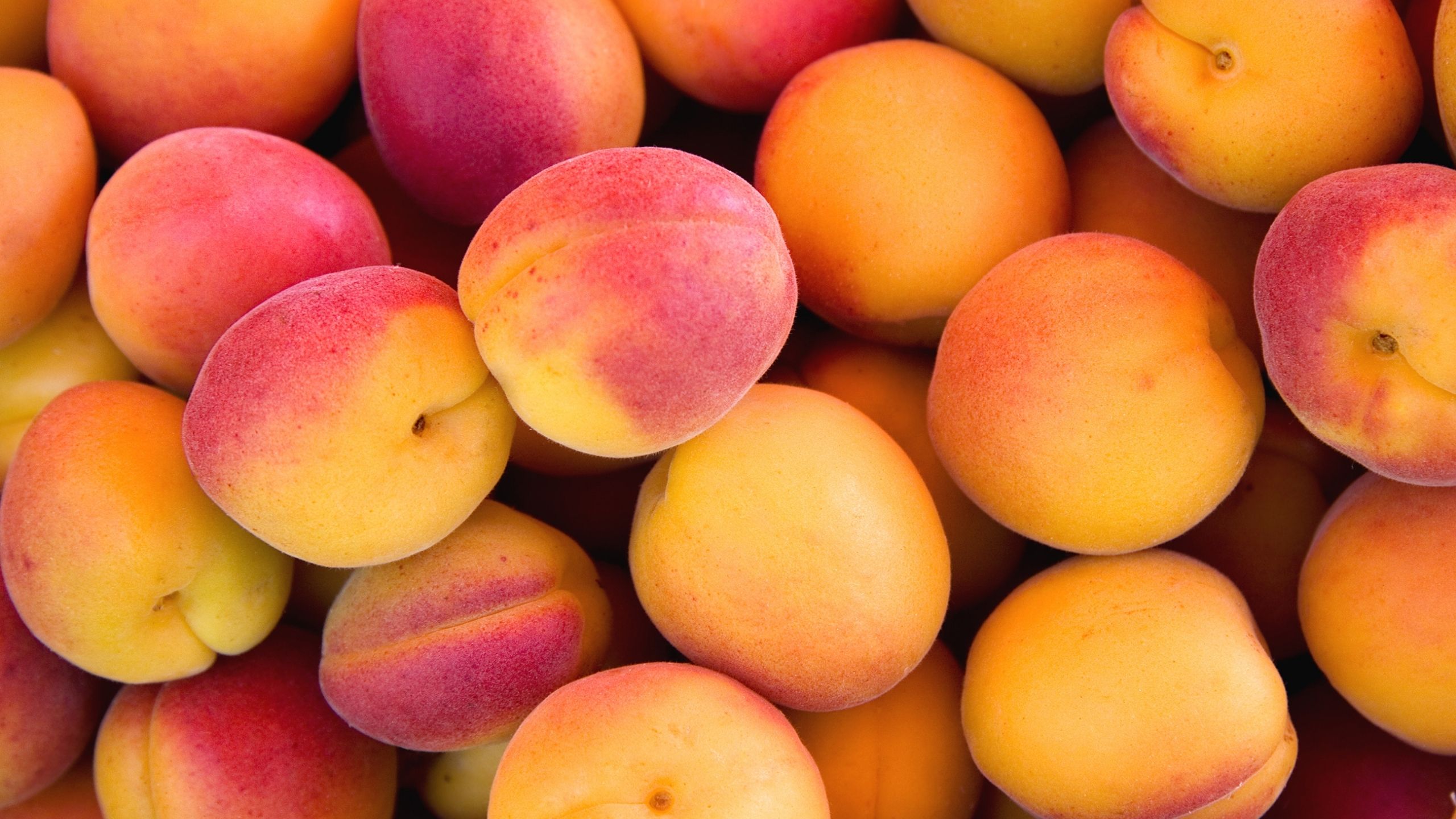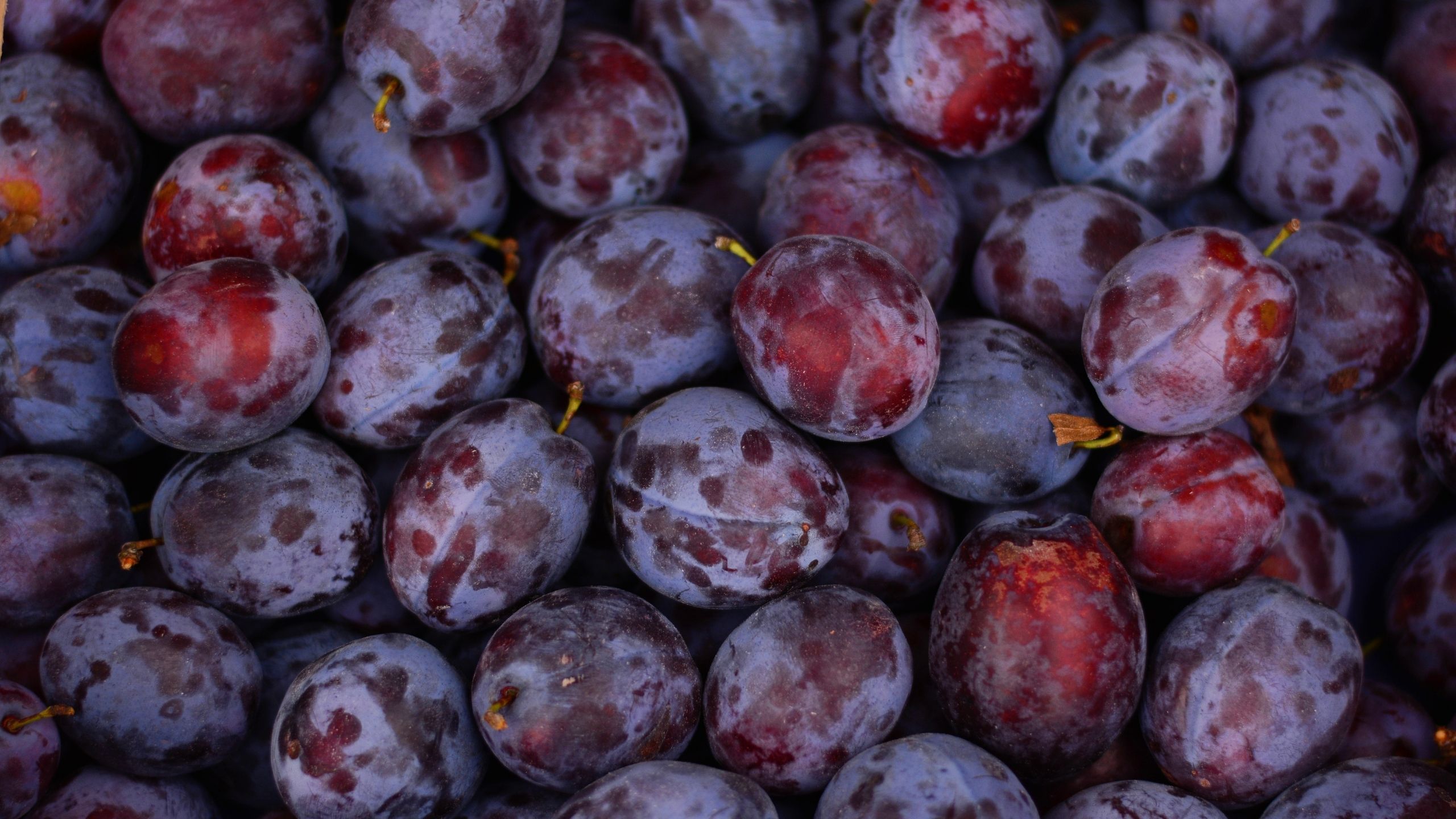Fruit Pests: Peach & Nectarine
The Backyard Orchardist
January 2020
Marion Murray, Extension IPM Specialist • Diane Alston, Extension Entomologist (No longer at USU)
DISEASES
(Listed in Order of Importance)

Coryneum Blight (Shothole)
Importance as a Pest on Peach/Nectarine: moderate-high
Other Fruit Hosts: apricot
General Info: Shothole is a common fungal disease in Utah. It attacks dormant leaf buds, blossom buds, leaves, fruit, and twigs. The first visible lesions occur on young leaves as small, round, tan spots that eventually fall out, leaving round holes. Circular lesions develop on fruit that first appear as reddish spots (shown right, top), and later as rough, corky bumps. Sometimes they are sunken (shown right, bottom). Infected buds die and exude gum, and twigs may be killed.
Symptoms:
- round, corky, or sunken spots on fruit
- dead twigs
- holes in leaves
- dead buds that ooze gum
Management: Prune and destroy all infected plant tissue. Prevent irrigation water from wetting leaves because the water will spread spores. For severe infections, apply a copper spray in fall when 50% of the leaves have dropped to prevent infections from occurring on fresh leaf scars.
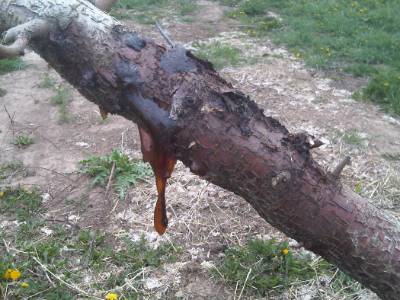
Gummosis
Importance as a Pest on Peach/Nectarine: moderate-high
Other Fruit Hosts: all stone fruits
General Info: Gummosis is a general term describing the prolific oozing of sap from a tree. Stone fruit trees are sensitive to injury, and will respond by exuding a gelatin-like gum in spring. Gumming is produced due to a variety of factors, including borers, diseases, or wounding. It can also be a response to poor growing conditions, such as compacted soil. If the oozing gum is clear, the problem is abiotic (non-living). If the ooze is milky or dark-colored, it is caused by an insect or disease.
Symptoms:
- gelatinous-like ooze on bark that is clear, milky, or amber colored
Management: To most accurately identify the cause of gummosis, consult your local county Extension agriculture agent.

Iron Deficiency
Importance as a Pest on Peach/Nectarine: moderate
Other Fruit Hosts: apple, berries, and cherry
General Info: Iron is a nutrient necessary for the formation of chlorophyll. Lack of chlorophyll means reduced photosynthesis, and reduced tree vigor. Iron deficiency commonly affects peaches and nectarines, and it must be managed every year. Iron deficiency is not caused by a lack of iron in the soil, but rather Utah’s high pH soils (which ranges from 7.5 to 8.5). In high pH, iron is insoluble, and therefore not available for root absorption. Because irrigation and rain water are also very alkaline, trying to manage iron deficiency by reducing soil pH is impossible. Iron deficiency is exacerbated by frequent springtime irrigation or prolonged soil wetness. Some trees are genetically more susceptible to nutrient deficiencies than others.
Symptoms:
- interveinal chlorosis (yellowing between veins)
- blackened scorching, curling, or premature leaf drop (under severe conditions)
Management: To prevent or treat iron deficiency, chelated iron (in the form of FeEDDHA, such as Miller’s Ferriplus) should be applied to the soil or foliage, but results are temporary. (Chelated products are readily available for absorption, and are not affected by soil pH.) Soil applications should be made in the spring before leaves emerge, and worked into the root zone. For minor deficiencies, one application will last all season. Foliar sprays (0.1%) with a spreader-sticker provide quick results but must be reapplied at approximately 10- to 21-day intervals. The drawback of foliar sprays is that staining of fruit can occur. To accurately identify nutrient deficiencies, the USU Analytical Lab (435-797-2217) can test foliar and soil samples.

Perennial Canker
Importance as a Pest on Peach/Nectarine: moderate
Other Fruit Hosts: apricot, cherry, and plum
General Info: Also called cytospora canker, perennial canker is caused by a fungus. Cankers are areas of dead cambium and bark and can occur on stems, limbs, and twigs. They are off-color, usually oval-shaped, and usually slightly sunken. Dark amber gum may exude from the canker edges. Cankers enlarge yearly or advance down side branches. Spores spread this fungus during wet weather, and successful infections occur in weak or wounded tissue.
Symptoms:
- yellowing
- distortion
- stunting
- reduced yield
- rusty spot on fruit (apple mildew)
- white powdery residue, which is a mixture of the fungal mycelium and spores
Management: To prevent fruit infections, rake and remove all leaves and debris in fall. A fungicide such as sulfur works by preventing infections, rather than “curing” infected tissue. If apples are nearby, control powdery mildew on those trees.
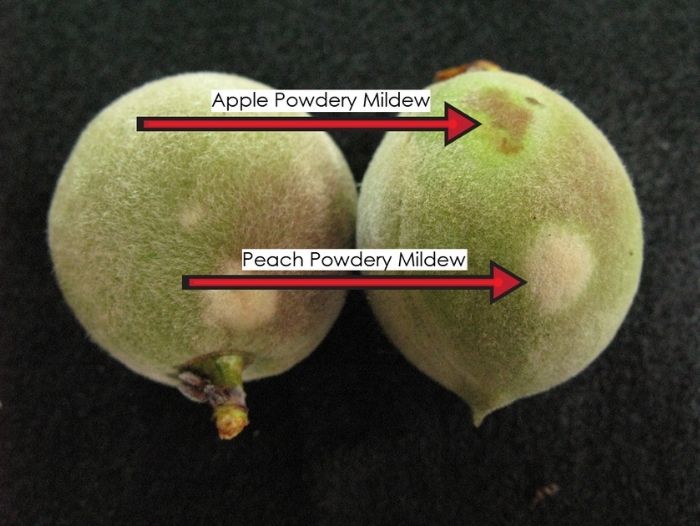
Powdery Mildew
Importance as a Pest on Peach/Nectarine: low
Other Fruit Hosts: apple, cherry, nectarine, peach, berries, and grape
General Info: This fungus attacks leaves and fruit. The apple powdery mildew fungus only causes a rusty mottling of the peach/nectarine fruit. Peach powdery mildew affects both foliage and fruit, and causes white fuzzy spots on both. Infections begin in late spring, during warm days, cool nights, and when moisture is present. The spores are spread by wind, dripping dew, rain, and irrigation.
Symptoms:
- round, corky, or sunken spots on fruit
- dead twigs
- holes in leaves
- dead buds that ooze gum
Management: Prune and destroy all infected plant tissue. Prevent irrigation water from wetting leaves because the water will spread spores. For severe infections, apply a copper spray in fall when 50% of the leaves have dropped to prevent infections from occurring on fresh leaf scars.
INSECTS
(Listed in Order of Importance)

Peach Twig Borer
Importance as a Pest on Peach/Nectarine: moderate-high
Other Fruit Hosts: apricot
General Info: In spring, chocolate brown larvae emerge from overwintering sites on peach limbs and then tunnel into succulent shoot tips. Infested twigs die back and small amounts of gum may exude from tunnel openings. In summer, a second generation of these “worms” enters fruit when succulent shoot growth has ceased. Larvae typically enter fruit near the stem end. In backyard orchards, injury may not be severe enough to require treatment every year.
Symptoms:
- wilted twigs
- holes in fruit with sawdust-like frass
Management: Peach twig borer activity is determined by seasonal temperatures, and the timing of activity varies from year to year. To find out when peach twig borer is active in your area of the state, and for spray recommendations, contact your local county Extension agriculture agent or subscribe to the USU IPM Tree Fruit Advisory. Conventional insecticide options include products containing a pyrethroid (ingredients ending in “thrin”), carbaryl, or malathion, and organic options include products containing spinosad or Bt (Bacillus thuringiensis).

Greater Peachtree (Crown) Borer
Importance as a Pest on Peach/Nectarine: moderate
Other Fruit Hosts: apricot and plum
General Info: This insect is a clearwing moth and the larvae tunnel in the cambium, just below the bark. Backyard orchardists should look carefully for gummosis mixed with frass (sawdust-like excrement, shown at right) at the base of the tree. In late June, female moths begin laying eggs on the base of tree trunks or upper roots. Young trees and old or droughtstressed trees are most vulnerable.
Symptoms:
- slow growth
- dieback in crown
- gummosis at soil-line
Management: Remove all weeds and tall grass from around the base of the trunk. Preventive trunk sprays (permethrin or carbaryl) is the main control tactic for conventional management. Apply once per month from early July through September, on the lower 12 -18” of trunk and exposed roots. Organic options include products containing spinosad (apply every 10 days), or the use of beneficial nematodes. (Contact your local county Extension agriculture agent for more information on the use of nematodes.

Aphids (Green Peach Aphid)
Importance as a Pest on Peach/Nectarine: moderate
Other Fruit Hosts: stone fruits
General Info: Aphids are small, soft-bodied insects that often occur in clustered colonies. They suck sap from the phloem vessels and reduce tree vigor. Watch for curled (shown at right) and sticky leaves due to honeydew excreted by the aphids. Black sooty mold may grow on the honeydew staining the leaves and fruit. Aphids migrate to alternate hosts for the summer.
Symptoms:
- curled leaves
- yellowed leaves
- sticky honeydew
- leaf drop
Management: Numerous beneficial insects (e.g., lady beetles, lacewings, and syrphid flies) help suppress aphid populations, so conserve and protect these natural enemies by limiting pesticide applications and adding nectar-providing flowers. The backyard orchardist can usually ignore aphid infestations unless the populations are extremely high. Apply 2% oil at budbreak to kill eggs. During the growing season, insecticidal soap or 1% horticultural oil can suppress aphids.
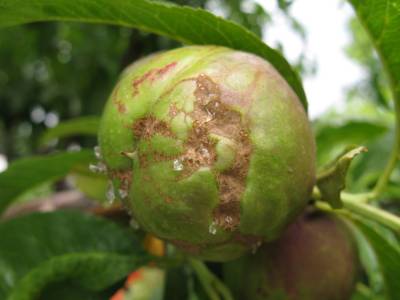
Western Flower Thrips (on Nectarine)
Importance as a Pest on Peach/Nectarine: moderate
Other Fruit Hosts: apple and plum
General Info: Thrips are minute, thin insects that feed within the flowers and on young fruit. They are primarily a problem of nectarines at bloom. Their feeding damages the fruit and scars form as fruit matures.
Symptoms:
- fruit scarring/russeting
- deformed fruit
- clear gumming from scarred areas
Management: Only an insecticide will prevent this injury. Spinosad can be applied when petals drop from flowers, and at dawn or dusk, (when bees are not foraging).
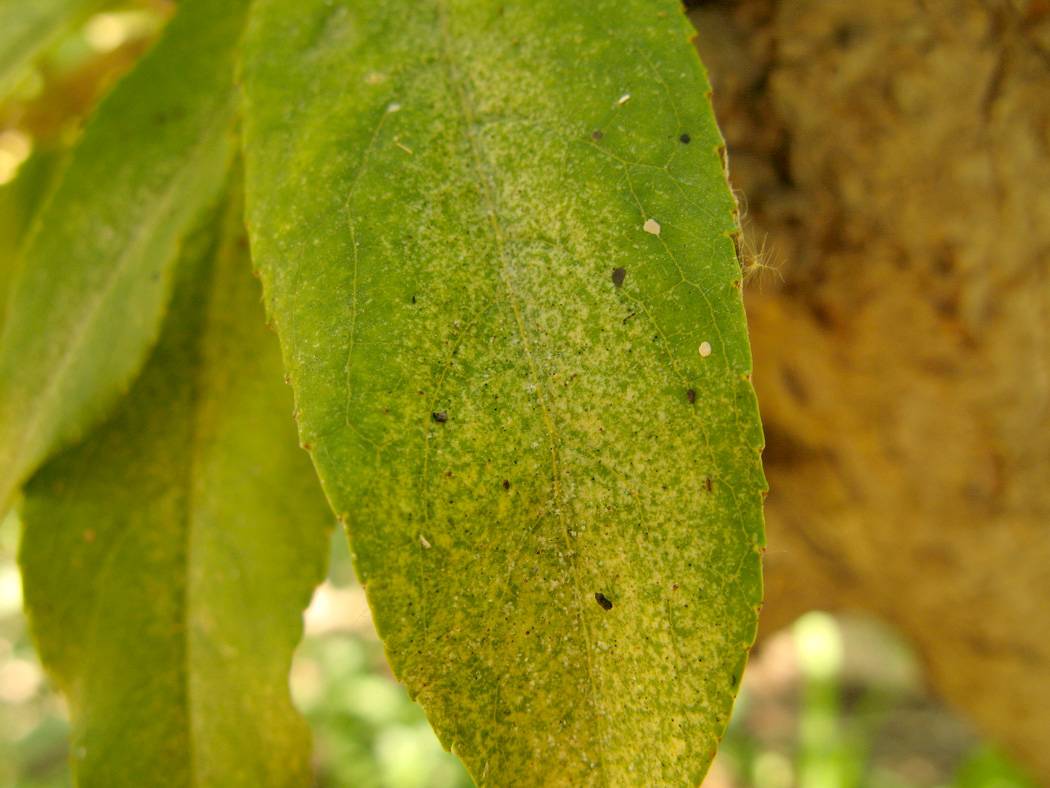
Spider Mites
Importance as a Pest on Peach/Nectarine: moderate
Other Fruit Hosts: all fruits
General Info: Mites are very small arthropods that are more closely related to ticks than insects. Spider mites overwinter as adults at the base of trees and may become a problem during hot, dry conditions in mid and late summer when they reproduce rapidly (1-2 weeks to complete a generation). They remove chlorophyll from leaves, causing a stippled appearance.
Symptoms:
- stippled leaves
- loss of tree vigor
- fine silk webbing that becomes apparent when populations are high
Management: Low populations of spider mites can be ignored and are often kept in check by predatory mites. Spider mite outbreaks often follow pesticide applications that upset the predator-prey balance. If needed, apply insecticidal soap or horticultural oil every 5-7 days until mite densities decline. Avoid spraying soaps or oils at temperatures over 80°F, as some leaf burn may result.

Walnut Husk Fly
Importance as a Pest on Peach/Nectarine: low-moderate
Other Fruit Hosts: apricot (walnut is the primary host)
General Info: The walnut husk fly is similar to western cherry fruit fly. Although walnuts are the primary host, they can sometimes attack ripening peaches. The adults are about the size of a house fly and have patterned wings with an inverted “V” at the tip. Adults lay eggs on softening peach and nectarine fruits, and larvae (maggots) feed within the fruits.
Symptoms:
- holes in fruit
- white maggots in fruit
Management: If walnut trees are nearby, peach fruit may be attacked. To prevent egg-laying, spray (focusing on the fruits) in mid to late July with a products containing spinosad. Repeat again 7 days later.
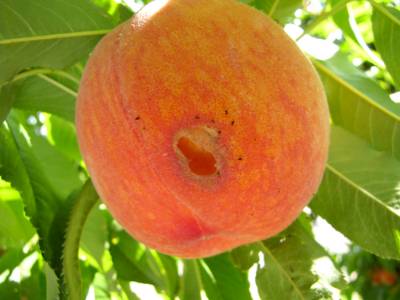
Earwigs
Importance as a Pest on Peach/Nectarine: low
Other Fruit Hosts: all fruits, but especially stone fruits and berries
General Info: The European earwig is not native to North America and has become a pest in arid western regions of western U.S. Earwigs will climb the trunk or stem and chew into fruits as they near maturity. They are especially fond of ripening fruit. They can also be predators on other insects, so their presence can sometimes be beneficial.
Symptoms:
- Round holes in fruit chewed by adults
- Black dots (excrement) near feeding areas
Management: Remove debris and weeds from touching the base of trees. Rolled cardboard strips tucked into limb crotches can be used to trap and remove earwigs from trees (remove and replace cardboard rolls). Another option is to wrapping the trunk with a 3” wide band of duct tape covered with tanglefoot (a sticky substance). If necessary, applying carbaryl or spinosad to the tree will provide a short interval of protection.
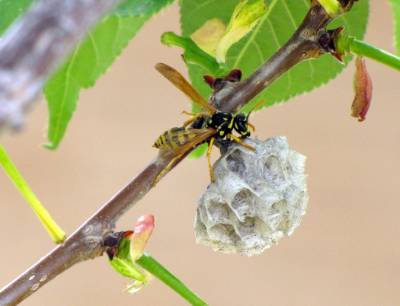
European Paper Wasp, Yellow Jackets
Importance as a Pest on Peach/Nectarine: low
Other Fruit Hosts: trees with soft ripe fruit
General Info: The European paper wasp builds umbrella-shaped nests in protected sites and yellow jackets build nests underground. The European paper wasp is very attracted to soft ripe fruit.
Symptoms:
- holes in fruit
Management: Clean up rotting fruit on the ground and regularly pick ripe fruit. To trap European paper wasps, cut the top third of a soda bottle off and invert it into the bottom portion. Punch holes along the top edges and insert wires for hanging. Fill the bottle with 1 part fruit juice, 10 parts water, and 1 tsp detergent. Hang the trap in peach trees or nearby areas just before fruit starts to ripen.


